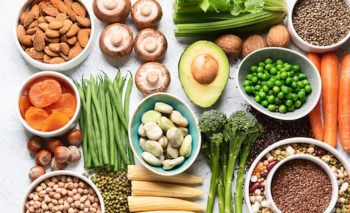The COVID pandemic brought a sharp focus to the high risk category that combines factors of aging with underlying conditions. We asked OE contributor and wellness expert, Michelle Milgrim, to help us understand how we can stay healthy with age. Her advice is inspiring.
Research shows us that aging well is not just about what you eat. There are many modifiable lifestyle factors that contribute to the aging process in addition to eating, like exercise, sleep habits, building a social support system, and managing stress. Unfortunately, there are also some things we just can’t change that also play a part in how we age, like family health history and existing conditions.
Age is the single largest risk factor for heart disease and stroke, macular degeneration and cataracts, cancer, disability, and mental decline like Alzheimer’s, the sixth leading cause of death in United States. Living well into our older years is not simply about the absence of disease or conditions, but the quality of our days. Up to 30% of Medicare recipients report difficulties with routine activities of daily living, like eating, getting dressed, and taking a shower.
So what is within your power to not only live longer, but thrive in your later years?
The Nurses’ Health Study, one of the largest investigations into the risks of major chronic diseases, including eye disease, has informed many key findings about the aging process and practical tips for living well throughout our years. Most importantly, this study identified that 90% of chronic disease can be prevented by making a handful of key lifestyle changes.

Image shows youthful seniors exercising outdoors.
- Maintain a healthy weight for your height, which means keeping your body mass index (BMI) within the normal range. For most, even a modest 5% weight loss can be enough to ease pressure on your lower joints making activity easier and more enjoyable, reduce risk of some cancers, prevent or delay type 2 diabetes, improve your lipid profile and reduce blood pressure, improve sleep, and reduce inflammation.
- Make physical activity a regular habit. Finding something that you enjoy, are able to do most days of the week, and can participate in with others is key to creating a consistent exercise routine. Regular physical activity, in whatever form you enjoy, can not only support weight loss and reduce disease risk, but it can help you maintain cognitive function, sustain mobility, prevent falls, and provide an important outlet for building social connection.
- Avoid tobacco. Quitting smoking is no easy task, but nicotine replacement therapies (NRT) have made it more approachable by reducing withdrawal symptoms and cigarette cravings. They have been found to double an individual’s chances of quitting for good. Tobacco cessation programs are a supportive complement to NRTs and are readily available in many communities, online or even via text on your mobile device. Visit SmokeFree.gov to learn more and get started.
- Moderate alcohol intake. Research shows that the more alcohol a person drinks—particularly, the more alcohol consumed regularly over time—the greater the risk of developing specific cancers as well as other conditions like heart disease, stroke, and cognitive impairment. Drinking alcohol can also replace other fluids in our diet like water or calcium-rich milk, increasing the potential for dehydration and bone fracture as we get older.
- Improve your diet. Follow a diet low in saturated fat, trans fat (mostly found in partially hydrogenated oils in processed foods) and sodium; limit intake of refined grains and sugary drinks; and eat more fruits, vegetables, legumes, nuts and unsaturated fats. This is the same basic healthy eating pattern that would benefit most regardless of age.
According to the Center for Disease Control and Prevention (CDC), only six percent of Americans engage in five key health-related behaviors that can prevent chronic disease, which includes getting enough sleep. About one-third of us manage to do at least three of these. So you’re in good company if you’re feeling overwhelmed by this idyllic list of goals. It’s not unattainable though. In fact, small changes can add up quickly and have a big impact on your personal well-being. If you’re not that active, consider adding a walk around the block after dinner with your spouse or a neighbor. If you’re diet leaves a bit to be desired, make one healthy swap at a single meal, like replacing half your usual morning bagel with an egg or low-fat Greek yogurt. If you’re drinking too much, cut back one drink at time, or alter your routine around the time you typically enjoy an adult beverage so you reduce the habitual craving. The idea is: think small then add small. Find small changes that you know you can make then up the ante each week or each month as the changes become an easier, more routine part of your lifestyle.

Image of fruits, veggies, legumes and nuts for healthy diet.
There are a few additional, unique dietary considerations as we reach the time of retirement:
- Calories: Unfortunately, every year we get older, our resting metabolic rate declines, which simply means we need fewer calories to sustain our aging bodies. This can quickly lead to unwanted weight gain if we don’t make some adjustments to our diet or activity. Paying careful attention to what and how much you eat, as well as introducing resistance exercise to build or maintain muscle mass, are important to maintaining energy balance. Most healthy, older adults need between 1600 to 2400 calories per day depending on gender, age, and activity level.
- Protein: Sarcopenia, or generalized loss of muscle mass and strength, can lead to frailty as we age. One way to combat this is to eat an adequate amount of high quality protein to support tissue maintenance and repair. The average adult needs between 45 to 60 grams protein daily. Higher quality protein sources include eggs, chicken, nonfat or low-fat milk, fish and lentils.
- Vitamin B12: Our ability to absorb vitamin B12 naturally decreases as we age. The richest sources of B12 include meat, fish, poultry, eggs, and milk. If you’re still falling short or follow a vegan/vegetarian diet, you can speak with your doctor about a supplement.
- Calcium and Vitamin D: Bone health becomes very important as we age. Making sure we get adequate calcium as well as vitamin D (to ensure the absorption of that calcium) is key to preventing osteoporosis and bone fractures. Dairy foods are the best source of dietary calcium because they are easily absorbed. Vitamin D is best found in fortified dairy products, but supplements can be used too.
- Water: As we get older, our sensation for thirst actually decreases, which means we may reach for our water bottles less and less. Healthy adults need about 1.5 to 2 liters of fluid daily, including water, milk, and fruit juices.
It is possible to age like a fine wine, and like wine its better savored alongside a good meal in the company of friends. Keep physically and mentally active, invest in your interests, embrace the love and support of your family and friends, savor special foods in moderation and be mindful of eating a balanced plate at most meals, and try your best to get a good night’s rest.
Try this recipe for a delicious on-the-go snack or quick bite, try these Maple Roasted Chickpeas which are sure to please all the senses.
Maple Roasted Chickpeas
- 1 30 ounce can reduced sodium chickpeas, rinsed and drained
- 2 Tbsp. maple syrup
- 1 Tbsp. brown sugar
- ¼ tsp ground cayenne
- ¾ tsp cinnamon
- ½ tsp ground Ginger
- Salt and black pepper to taste
Directions: Preheat oven to 425. Drain chickpeas and empty onto towel-lined baking sheet and pat until completely dry. Replace towel with parchment paper to line the baking sheet. Roast chickpeas in oven for 20 minutes, rotating and shaking halfway through cooking. Remove chickpeas and add to seasoning mixture. Coat chickpeas well and return to baking sheet. Bake another 10 to 15 minutes, or until crispy.
Recipe video available on Youtube.







